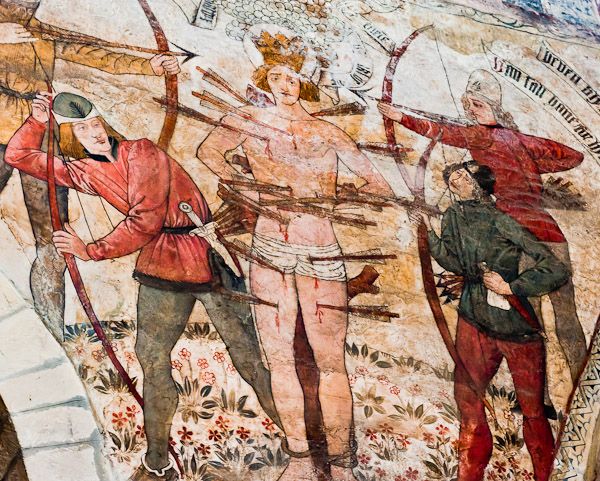Illustrated Dictionary of British Churches - Wall Painting Definition
History and Architecture
- Aisle
- Altar
- Ambulatory
- Angel Roof
- Apophyge
- Apse
- Arcade
- Arch
- Archivolt
- Base
- Battlement
- Bay
- Belfry
- Bell Tower
- Bellcote
- Bench End
- Board Bell Turret
- Body
- Boss
- Box pew
- Bracket
- Broach Spire
- Buttress
- Canopy
- Capital
- Cartouche
- Chancel
- Chancel Arch
- Chancel Screen
- Chantry
- Chapel
- Chapter House
- Choir
- Clerestory
- Cloister
- Communion Rail
- Compound Column
- Consecration Cross
- Corbel Head
- Crossing
- Crypt
- Early English
- Easter Sepulchre
- Effigy
- Fan Vaulting
- Font
- Font cover
- Funerary Helm
- Gallery
- Gargoyle
- Gothic
- Green Man
- Grotesque
- Hatchment
- Herringbone
- Hogback Tomb
- Holy Water Stoup
- Hunky Punk
- Jesse Window
- Kempe Window
- Lady Chapel
- Lancet
- Lectern
- Lierne
- Lych Gate
- Misericord
- Monumental Brass
- Mullion
- Nave
- Ogee
- Organ
- Parclose Screen
- Parish Chest
- Pendant
- Perpendicular Gothic
- Pew
- Pinnacle
- Piscina
- Poor Box
- Poppy Head
- Porch
- Priest's Door
- Pulpit
- Purbeck Marble
- Quire
- Rebus
- Reliquary
- Reredos
- Retable
- Romanesque
- Rood
- Rood Loft
- Rood screen
- Rood Stair
- Rose Window
- Round Tower
- Sanctuary
- Sanctuary Knocker
- Saxon Period
- Scratch Dial
- Sedilia
- Spire
- Statue Niche
- Stoup
- Tomb Recess
- Tracery
- Transept
- Triforium
- Tympanum
- Undercroft
- Vaulting
- Victorian Gothic
- Wall Monument
- Wall Painting
- Wheel Window
Wall Painting
Medieval churches in Britain were commonly decorated with murals, or wall paintings. In an age when very few people could read, such wall paintings served both as a decorative element, but also to instruct and convey religious messages in a way that worshippers could understand. Thus, wall paintings often showed scenes from Biblical stories or from the lives of saints.
Some common wall paintings themes include St Christopher, patron saint of travelers, whose likeness is often painted on the north wall of the nave, facing the main south door, where people coming into or leaving the church could see him.
Most wall paintings were destroyed or painted over during the Reformation. Some of those lost paintings that were plastered or whitewashed over have since been rediscovered and at least partially restored.
Among the most memorable medieval wall paintings in my memory are those at Lower Oddington (Gloucestershire), Pickering (Yorkshire), Stoke Dry (Rutland), and Duxford (Cambridgeshire).
During the post-medieval period it was fashionable to paint Biblical inscriptions on church walls, and these later wall paintings sometimes overlay and interlap with earlier medieval paintings. Perhaps the most fascinating post-medieval wall paintings are those at Garton-on-the-Wolds, Yorkshire, where it seems that every surface is covered in exquisitely detailed paintings of a cartoon-like quality.
Related: Nave






